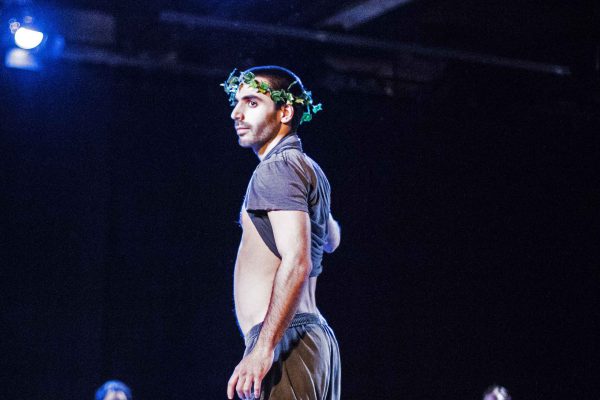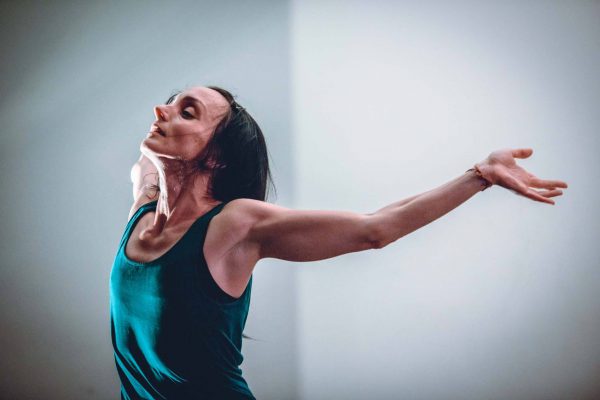If you listen to Peggy Baker describe her work move, she’ll tell you the piece is about the experience of giving and receiving care, of being tended to and tending to others. All of this is accomplished through the metaphor of eight partnered couples dancing together as equals. The pairs perform a sequence of movements that include recognizable markers of caring relationships — embracing and releasing, holding hands, separating and reuniting, leading and following, touching and being touched. Performed in the round, the piece is choreographed to work without a stage. The overall effect is to create a pool of dynamic, flowing intimacy that the audience observes at close proximity, often sitting only inches from the performers.
In every rehearsal Peggy reminds her cast to be generous — generous to our partners in offering touch and attention, and generous to ourselves by allowing ourselves to receive tenderness. In fact, Peggy calls move a ritual, and the accompanying music matches this idea with its cyclical ethereality. The movers dance in a prescribed sequence, repeated again and again, in a pattern that is oriented to the four cardinal directions, in a circumscribed frame that is demarcated (with tape) and consecrated as sacred ground for the duration of the piece. This space is guarded by the bodies of the dancers, arrayed around its perimeter at the beginning and end. They enter it with solemnity and exit with precision and gratitude.
I first saw move performed in Burlington, Ontario, in early 2018. At that time I was an exhausted health professional on a break from my clinical work. I wept through the entire performance. In the intimacy, mutuality and vulnerability demonstrated between the couples, I saw the meaning and connection I longed for in my work with patients. And I keenly felt my powerlessness to express this deeply human form of care within the institutional structures of health care that tend to value efficiency, professional distance, expertise, power and quantifiable outcomes, all of which have a tendency to crowd out the simple gestures of compassion that nourish connections between professionals and patients. My sense of alienation from the call to care that first drew me to my vocation and my desire to experience the relational, authentic, tactile form of care embodied in the choreography made me to want to dance the piece myself as a member of Peggy’s cast.
These relational and ritualized aspects of the piece are overt and accessible to the audience. But other dimensions of the genius of move are only revealed when it is embodied, in real time, with the whole cast of other moving bodies. I have gradually become conscious of these other aspects over the course of the hours I’ve had the privilege of working with Peggy and the cast she assembled to mount the piece for performance at the Art Gallery of Hamilton on February 2, 2019.
The Ground of Care
Just a few moments after entering the performance frame, we leave behind our bipedal human nature. After our fourth turn, we come to the floor and remain there for the duration of the sequence. Peggy has discovered an ingenious array of movements that allow us to move our own bodies and the bodies of our partners across and through the space horizontally. And while she takes great pains to make these movements as fluid and artful as possible, they often feel terribly awkward in the body. It is hard work moving against the ground. As humans we prefer to remain aloof from the earth, touching it only with our two feet. This gives us the illusion of being somewhat separate from what we walk upon. We feel more a part of the air and, with less resistance to push against, we can move faster and unencumbered, stepping over or jogging around whatever obstacles the planet might present on our path.
But in move we are stripped of our evolutionary arrogance and reduced to creatures of the earth. We are not pretty; there is very little elegance or precision or fidelity to line or form. Our lack of intimacy with the ground beneath us is betrayed again and again as we get stuck, push away instead of reaching through, lose our basic orientation to the world and constantly have to ask for directions from our partner. Through this choreography, I’m reminded that the earth is the ground of our living and caring for one another and that our very survival as a species is dependent on us working with and not against it — to flow more care to the earth herself.
The Ecology of Care
As soon as more than one couple enters the frame, it becomes clear that the act of giving and receiving care is not contained within the dyad of the couple. Rather, the performance functions as an ecology of care.
Ecologies are complex, adaptive and ever-changing systems. Each part of the ecology — each species of plant, lichen, bacteria, bird, insect and animal, as well as inorganic materials like rocks and minerals — is intricately connected to every other part, often in ways that are not visible until the tendrils of the relationship are disrupted. What happens to bees impacts plants, which impacts bacteria, which impacts soil, which impacts trees, which impacts birds and so on.
In the ecology of care embodied in move, every couple relies on the care and tender attentiveness of one another. But they also rely upon the attentiveness of every other couple both inside and outside the frame of the dance. If one couple steps into the frame too late, it creates a bottleneck down the line ten minutes into the sequence; if one couple doesn’t hit their mark for a turn in direction, another is blocked from proceeding down their own corridor. Every dancer must simultaneously attune to themselves and their own needs, to their partner and their needs, and to the needs of every other mover around them. When such attunement is present, there is a sense of flow in the overall dynamics of the piece externally, and this flow is also felt intuitively in the bodies of the dancers, who can sense whether the couples around them are struggling or relaxed, blocked or racing to catch up. Equilibrium within the dynamics of the dance feels deeply nourishing; disequilibrium feels alarming and treacherous.
This ecology of care is a microcosm of the ecology I feel every day as a caregiver. My capacity to be present, tender and open to my patient and to partner with them in the work of healing is intimately and yet invisibly dependent upon the wellness and flow of every part of the system that supports and contains me and my patient. For example, if the emergency department isn’t too overwhelmed, my patient’s nurse will not have to take extra patients and may get to enjoy his lunch break. If he gets his break, he may feel more energized to take on a discretionary task of care, like bathing my patient, nurturing his body and spirit with warm water and warm banter in the process. If my patient gets a bath and feels fresh and dignified, he will greet me with clarity and courage rather than despondence and anger. And that patient’s demeanour will impact my own ability to listen to his story, to speak with compassion and to support him to make choices that support his values and goals. Each part of the system, each player, influences both the care received and the care given.
All of us are caregivers to someone — the sick, the old, the young, the mentally or spiritually infirm, the sad, the lonely, the outcast, the lost, the difficult. And all of us are enmeshed in ecologies of care. There is no independence, only interdependence. As we walked, crawled, slithered and burrowed through move, we embodied ecological interdependence, how each of us is connected to every other thing that walks, crawls, slithers and burrows on this earth with us.
The Vessel of Care
Over my years working as a dancer and a health-care professional, I have learned that what both groups have in common is their “game face.” Experienced health-care professionals don’t lose their cool or show their fear or betray their uncertainty even when a patient is dying in front of them or all hell is breaking loose in the ward around them. Similarly, dancers have a way of masking enormous physical pain, anxiety, disorientation and ambition behind their seeming effortless grace. But make no mistake, dance is a costly form of art, paid in the currency of the body.
move is performed almost entirely on the floor. Throughout the hour-long piece, we dancers crawl, roll, kneel, push up and lie down. Our bodies come into repeated contact with the unyielding surface of the floor again and again, grinding down tender places where the bones are closest to the surface (knees, elbows, hips, pelvis, shoulder blades). These parts of the (adult) body are generally unaccustomed to any pressure but that of the air they are suspended in during the day or the soft bed they rest on during the night.
In medicine, the vessel through which care is delivered is often a technology: a diagnostic test, a pill, an IV injection, a surgical intervention, a rehab regimen. But in move the vessel of care is the body of the carer. And in move we feel the physical cost of caring. We feel it in the changes in the breath as our exertion mounts through the piece. We feel it in the relief we feel when we come to (rare) points of stillness. We feel it in the twisting of our skeletons into unaccustomed arches. We feel it in the blossoming crop of bruises that erupt just hours after every rehearsal, whose flowers change from purple to green to yellow just in time to sow the next crop at the next rehearsal. We feel it in the stamina required to push through cycle three and the relief felt when cycle four begins. We feel it in the dampness of our clothes, our thirst and our bedraggled hair when we finally come to rest at the close, looking every bit like we have been in a battle to love and be loved.
But this work also reveals to us the enormity of our human need to touch and be touched. Incredible gratification comes with guarding your partner through a difficult turn and when our partner lifts us into their arms and invites us to do nothing but rest a moment. It makes no bones about the work of caring. It is exhausting. It is exhilarating. It is difficult. It hurts. It costs us something. It is done, ultimately, with and through the vessel of the body. And it’s the body that registers, in spite of the pain, the goodness of caring and being cared for.
The Dynamics of Care
I have had the incredible opportunity to dance move with my twelve-year-old daughter, Artemisia. It has been an extraordinary gift to me on many levels. The choreography requires both of us to take turns as caregiver and care receiver. Giving care to Artemisia is a role I am accustomed to. I have thirteen years of practice. Her life’s journey began nested inside my own body, so I have deep instincts about how to protect her, attend to her and nurture her. As she becomes a teenager, she is naturally and rightly becoming more independent of me and my care. In public we no longer hold hands. She has clearer personal boundaries and invites touch and affection less frequently. She no longer needs my constant attention and affirmation because her own circle of friends and teachers and mentors provide her with other mirrors and supports. All of this is healthy, normal teenage stuff, which I celebrate as signs of her growing independence. But it also comes with a sense of loss for me and circumspection on how fleeting our time — with cuddles and hugs and kisses and arms entwined around shoulders and hand in hand — really is.
Dancing move with Artemisia has in some ways transported us both back in time, to a time when we were constantly in physical contact, when she needed my vigilance to keep her safe. It has given me great joy to feel so connected to her and to feel her give her body into my care, as she did when she was a young child. Through the rehearsals I have become familiar with her body again. I have also been confronted with the fact that hers is not a child body but a tall, lithe, strong, womanly body. Through the process I’ve become keenly aware that I no longer hold her, relate to her as woman to child but as woman to woman. There are no words to describe the sharp tenderness and gleaming pride this awareness evokes in me.
move has also thrust us forward in time, to a time when our roles will be reversed and she will care for me. In the choreography Artemisia becomes my guide through the space, my eyes to manoeuver around other dancers, my compass to navigate me to my marks, my coach to modulate my pace. Artemisia physically tends to my body — curling in my limbs, rolling my torso, spooning my back, lifting me again and again into her arms of embrace. Receiving physical care and guidance from my daughter is a new experience for me and a strangely ambivalent one. I have found myself subtlety resisting her care at times. I am not used to her being in control. Sometimes I find myself trying too hard to do things for myself; other times I over-anticipate her next direction or expend too much energy in my effort to alleviate my burden on her.
But move is a marathon not a sprint. You wear down quickly if you don’t allow yourself the rest that comes with being cared for by your partner. By the third rehearsal, I realized that my resistance to allowing my daughter to care for me was exhausting me physically and emotionally and that it was subtlety conveying to her the message that I don’t trust her. Artemisia has shown me, hour after gruelling hour, in her whispered directions, her firm hands, her mastery of the map of the piece, that I can trust her to take care of me, that my body is in good hands when she holds me. Through move I am learning how to mother my woman-daughter and to be mothered by her in turn; I am learning to relax into new dynamics of care as we both grow and change and dance our own steps (together and separately) into the future.
move is a work of art, not because it is technically rigorous or virtuosic but because it takes the most basic human experience of giving and receiving care and peels it back, layer upon layer. As a dancer, it has opened new vistas in my own understanding of the dynamics at play in my work as a health-care professional and as a mother, sister, partner, friend, mentor, student and human dancing a complex ecology of care. Peggy has captured what theologian Jean Vanier writes about: “I have learned that the process of teaching and learning, of communication, involves movement, back and forth: the one who is healed and the one who is healing constantly change places. As we begin to understand ourselves, we begin to understand others.”
Thank you, Peggy, for the gift of moving through move.
Tagged: Contemporary, Writers & Readers, Hamilton , ON




Who Tells and Cries Our Freedom?